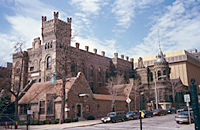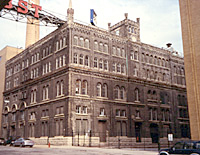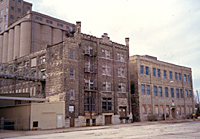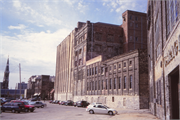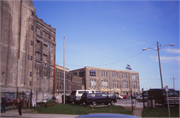Roughly bounded by Highland Avenue, Eleventh, Winnebago and Ninth streets
| Historic Name: | Pabst Brewing Company Complex |
|---|---|
| Reference Number: | 03001165 |
| Location (Address): | Roughly bounded by Highland Avenue, Eleventh, Winnebago and Ninth streets |
|---|---|
| County: | Milwaukee |
| City/Village: | Milwaukee |
| Township: |
| Pabst Brewing Company Complex 807 W. Juneau Avenue, Milwaukee, Milwaukee County Architects: Charles Hoffmann and Otto Strack Dates of contributing buildings: 1858-1953 The Pabst Brewery was the principal production facility for one of the largest brewers in the world. Founded in 1844 by Jacob Best and his sons, the brewery originally produced ale, porter and whiskey in addition to the lager beer for which it ultimately became famous. Former steamship captain, Frederick Pabst entered the business in 1864 following his marriage to the daughter of Phillip Best, who inherited the business from his father. Two years later, Captain Pabst became company president and, by 1868, the brewery was the largest in Milwaukee. In 1874, it had become the largest in the nation brewing 114,162 barrels of beer. Late nineteenth century mechanical and scientific advancements - many of which were either pioneered or refined at the brewery - improved the consistency of beer and helped increase production. These included better carbonation techniques, the use of strains of yeast more suited to brewing, and the introduction of numerous devices such as barley washers, improved filters, hop extractors and bottling equipment. On March 18, 1889, the business was renamed in honor of Captain Pabst who had overseen an increase in production from fewer than 5,000 barrels in 1864 to over 500,000 barrels by 1889. In 1892, aided by aggressive promotion and a wide distribution network, the brewery became the first to produce over one million barrels of beer in a single year and stood as the largest lager brewery in the world. One of its most popular beers was its "Select" brand, which, with a blue silk ribbon tied to each bottle, served as the precursor of Pabst's trademark "Blue Ribbon" beer. These staggering production increases necessitated the construction of numerous specialized industrial buildings at the brewery, including a brewhouse, malt house and bottling works. Many of these buildings feature elements like battlements and crenellated towers, which reflect the German origins of Captain Pabst and, generally, the Germanic character of late nineteenth century Milwaukee. The Pabst Brewing Company Brewery Complex occupies 18.4 acres near downtown Milwaukee. Some buildings have been rehabilitated and are open to the public. |
| Period of Significance: | 1875-1953 |
|---|---|
| Area of Significance: | Architecture |
| Area of Significance: | Industry |
| Applicable Criteria: | Event |
| Applicable Criteria: | Architecture/Engineering |
| Historic Use: | Industry/Processing/Extraction: Manufacturing Facility |
| Historic Use: | Commerce/Trade: Business |
| Architectural Style: | Modern Movement |
| Architectural Style: | Late Victorian |
| Resource Type: | Building |
| Architect: | Strack, Otto |
| Architect: | Hoffmann, Charles |
| Historic Status: | Listed in the National Register |
|---|---|
| Historic Status: | Listed in the State Register |
| National Register Listing Date: | 11/14/2003 |
| State Register Listing Date: | 07/18/2003 |
| Number of Contributing Buildings: | 24 |
|---|---|
| Number of Contributing Sites: | 0 |
| Number of Contributing Structures: | 3 |
| Number of Contributing Objects: | 1 |
| Number of Non-Contributing Sites: | 0 |
| Number of Non-Contributing Structures: | 3 |
| Number of Non-Contributing Objects: | 0 |
| National Register and State Register of Historic Places, State Historic Preservation Office, Wisconsin Historical Society, Madison, Wisconsin |

